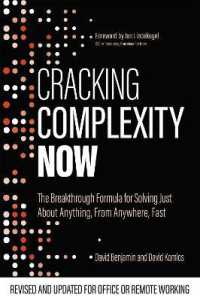- ホーム
- > 洋書
- > 英文書
- > Politics / International Relations
Full Description
From 1978 through the turn of the century, China was transformed from a state-owned economy into a predominantly private economy. This fundamental change took place under the Chinese Communist Party (CCP), which has been ideologically and politically predisposed to suppress private ownership.
In Dancing with the Devil, Yi-min Lin explains how and why such a paradoxical reality came about. He shows that private ownership became a necessary evil for the CCP because the public sector was increasingly unable to address two essential concerns for regime survival: employment and revenue. Focusing on political actors as major change agents, Lin examines how their self-interested behavior led to the decline of public ownership in the context of China's evolving demographics and fiscal system. The constraints and incentives associated with these factors help explain CCP leaders' initial decision to allow limited private economic activities at the outset of reform. They also shed light on the ballooning opportunism among lower officials, which undermined the vitality of public enterprises. Furthermore, they hold a key to understanding the timing of the massive privatization in the late 1990s, as well as its tempo and spread thereafter.
Dancing with the Devil illustrates how the driving forces developed and played out in these intertwined episodes of the story. In so doing, it offers new insights into the mechanisms of China's economic transformation and enriches theories of institutional change.
Contents
Introduction
Privatization and Institutional Change: Toward an Eclectic Perspective
Driving Forces of Privatization
Political Actors as Change Agents: The Main Storyline
Note on Statistical Analyses, Data Sources and Chinese Materials
1. The Changing Fate of Private Ownership since 1949
Socialist Transformation and the Mao Era
From Getihu to "Equal Protection" of Public and Private Property Rights
Reversal or Moderation of Privatization?
Broad Trends of Change
Summary and Questions
2. Demographic Pressures
Structure and Change of the Post-1949 Population
Buildup of Employment Pressures
Labor Market: Occupational and Spatial Movements
Ageing and Old Age Support
Summary
3. The Evolving Structure of Public Finance
"Unified Revenue and Spending"
Fiscal Contracts
Revenue Partitioning
Implications
4. Careerism and Moral Hazard in Early Marketization
Large Is Beautiful: Political Performance Assessment under Economic Decentralization
The TVE Spectacle
The SOE Sideshow
Summary
5. Rule Bending for the Necessary Evil
Uneven Paces of Early Privatization
The Wenzhou Story Retold
Beyond Wenzhou
Summary
6. FDI and Privatization
Centrally Imposed Constraints and Local Rule Bending
FDI Entry Mode and Resource Dependence
Bi-polar Concentration of Risk Taking
Summary
7. The Tipping Point and Beyond
The Triggers
The Political Bandwagon
From Industrial Development to Urbanization
Asset Stripping and Insider Control
The End Game: SASAC and the Remaining SOEs
Summary
Conclusion
Institutional Stability and Unintended Consequences of Rule Compliance
Non-compliance and Political Risk Management
Path Dependence in Endogenous Institutional Change
Bibliography








